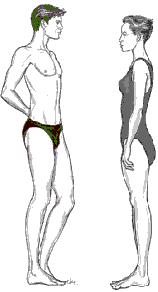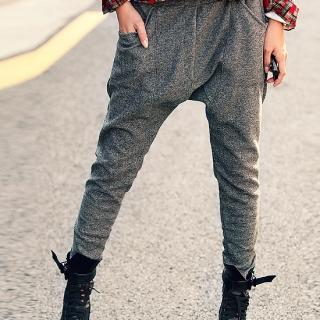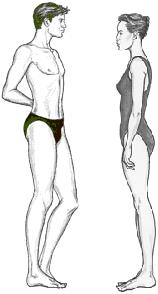If you are satisfied with your body shape, you are either Mister or Miss Universe. Am I right? I mean, how many of us really think that our body shape is perfect? There are always problems like unbalance size, plus size, lack of curves or curved at the wrong side. What I'm trying to say is... none of us are perfect. However, whether you like your body or not, if you understand your body shape and the proportions of your body well, then you are definitely on your way to the best look of yourself.
There are several factors that involved in a full style analysis. These include assessing your:
- Vertical body shape
- Horizontal body shape
- Face shape
- Weight
- Height
- Bone structure
- Shoulder length and angle
- Neck length and circumference
- Age
What's the perfect shape?
OK, let's think positive. Beauty is in the eye of the beholder. However, the stereotype perfect female body shape is moderately tall with a vertically balanced body, an hourglass figure and an oval shaped face. For males, the ideal is tall with a vertical balanced body and a trapezoid torso (broad shoulders and chest tapering to medium waist and hips) and an oval face.
Do you have a perfect shape?
You can actually create the illusion of a perfect body shape by choosing the right clothes to portrait the perfect proportions. It's all about balancing your perceived shape to the "perfect" shape. You can change your body shape through diet and exercise or, more drastically, through plastic surgery. If you do change shape by more than 5.5cm (2 inches) then you should re-assess your body shape and ensure your clothing choices fit your current shape (neither too tight not too loose).

Determine your body shape
Start by assessing your vertical body proportions and compare the bottom half and top half of your body.
Vertical shape is important for identifying your best garment lengths (tops and bottoms) and will determine if you should tuck-in tops or wear top garments untucked.
There are three vertical body types (applicable to male and female). The most accurate way to determine your vertical shape is to measure your full height and the height to your hip-line (circumference around your fullest hip) and determines relation between your hip-line and your height.
Use the rough assessment guidelines below:
Short legs, long torso

If your legs are short compared to your upper body you have short legs and a long torso...
- Your hip-line height is less than half your height
- You may also have a low waist -- your waist will be lower than your bent elbow
- You will have a long torso -- typically you will put on weight first on your thighs and hips
- Your bottom will typically be low and heavy
- You may also be short – although tall people can also be short legged
Aim:
create the illusion of longer legs and a shorter torso.
Do wear:
- Jewellery, scarves and garment designs that draw the observer's eye up towards your shoulders and face
- Short or medium-long tops
- Tucked-in tops (for slim people)

- Layered tops
- Medium or light tops and dark pants or skirts
- Medium or wide belts
- Straight skirts
- Straight or boot-leg pants
- Pant, sock and shoe (same colors)
- Medium or high heels
- Pant hems to the ground
Don't wear:
- Long tops
- Pants with low waistband

- Cropped pants
Balanced body

Your upper body length is about the same size as your lower body length.
- Your hip-line height is half your full height
- Your waist is at your bent elbow
- You tend to put on weight around your torso or hips and thighs
- You probably have a round well formed bottom or you have a flat bottom
- You have proportionally slim arms and legs
Aim:
elongate your mid-torso.
Do wear:
- Jewellery, scarves and garment designs that draw the observer's eye up towards your shoulders and face
- Medium-long or long tops
- Untucked tops
- Tops and dresses that flow through the waist
- Skirts and pants with narrow waistbands or no waistband

- Straight or flared skirt
- Low waist or hipster pants
- Straight or flared pants
Don't wear:
- Short tops
- Empire line tops and dresses
- Skirts or pants with wide waistband
Wide belts
Long legs, short torso

Your legs are longer than your upper body. You have a long legged vertical body type.
- Your hip line height is higher than half your full height
- You should also have a high waist -- your waist will be higher than your bent elbow
- You will have a proportionally short torso
- Your bottom will typically be round and high
- You tend to put on weight around your waist, above your waist or on the back of your hips
- You may also be tall -- although short people can also be long legged
Aim:
create visual balance by creating the illusion of a longer mid-torso and shorter legs.
Do wear:
- Design details that draw the eye down, such as border prints on skirts and pants
- Medium-long or long accessories
- Skirts and pants in a lighter colors than tops
- Medium-long or long tops
- Untucked tops
- Tops and dresses that flow through the waist
- Skirts and pants with narrow waistbands or no waistband
- Straight and flared skirts or pants
- Low waist or hipster pants
Don't wear:
- Clothes that draw the eye upwards
- Pin stripes
- Short tops
- Empire line tops and dresses
- Wide belts
- Pants or skirts with a high waistband
- Tapered pants and skirts
So these are some of the simple guidelines which might help you to dress perfectly according to your body shape.
:: SHIN ::

No comments:
Post a Comment